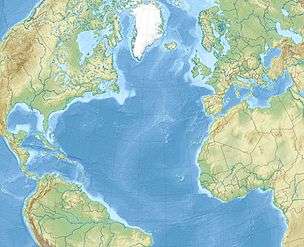SS Empire Tower
SS Empire Tower was a British 4,378 GRT cargo ship built in 1935 and sunk by enemy action in 1943.
| History | |
|---|---|
| Name: | SS Roxburgh[1] |
| Namesake: | Roxburgh, Scotland |
| Owner: | B.J. Sutherland & Co.[1] |
| Port of registry: |
|
| Builder: | Burntisland Shipbuilding Company Ltd, Fife, Scotland[2] |
| Launched: | March 1935[2] |
| Identification: |
|
| Fate: | sold 1937[2] |
| History | |
| Name: | SS Tower Field[1] |
| Owner: | Tower Steamship Co. |
| Operator: | Counties Ship Management, London[1] |
| Port of registry: |
|
| Out of service: | 19 October 1941[1] |
| Identification: |
|
| Fate: | ran aground & broke in two[3] |
| Name: | SS Empire Tower[1] |
| Owner: | Ministry of War Transport[1] |
| Operator: | Counties Ship Management, London[1] |
| Port of registry: |
|
| In service: | December 1942[1] |
| Out of service: | 5 March 1943[1] |
| Identification: | UK official number 161579[2] |
| Fate: | sunk by torpedo 5 March 1943[1] |
| General characteristics | |
| Type: | cargo ship[2] |
| Tonnage: | |
| Length: | 372.0 ft (113.4 m)[2] |
| Beam: | 52.4 ft (16.0 m)[2] |
| Draught: | 24 ft 5 in (7.44 m)[2] |
| Depth: | 25.2 ft (7.7 m)[2] |
| Installed power: | 335 NHP |
| Propulsion: | triple expansion steam engine;[2] single screw |
| Crew: | 39 plus 6 DEMS gunners[1] |
She was built by the Burntisland Shipbuilding Company Ltd. in Fife, Scotland. The North Eastern Marine Engineering Co. Ltd. of Sunderland built her 335 NHP three-cylinder triple expansion steam engine.[2] She had six corrugated furnaces with a combined heating surface of 117 square feet (11 m2) heat to heat her three 180 lbf/in2 single-ended boilers, which had a combined heating surface of 5,445 square feet (506 m2).[2] She was fitted with direction finding equipment.[2]
She was launched as SS Roxburgh for B.J. Sutherland and Company of Newcastle-upon-Tyne.[1] In 1937 the Tower Hill Steamship Company, an offshoot of Counties Ship Management, bought her and renamed her SS Tower Field.[1]
Damage and repair
On 10 May 1941 Tower Field was steaming in ballast from London to Newcastle when a German aircraft attacked and damaged her off the Outer Dowsing Buoy in the Thames Estuary.[3] She was repaired and returned to service.[3]
On 19 October 1941 she was entering Workington Channel off Hull with a cargo of iron ore when she ran aground and fractured her hull.[3] She broke in two but her cargo was discharged and she was refloated and repaired.[3]
The Ministry of War Transport took her over and renamed her SS Empire Tower but kept her under CSM management.[2] She returned to service in December 1942.[3]

Sinking
Early in 1943 Empire Tower, under Captain David John Williams OBE, joined Convoy XK-2 from Gibraltar to the UK.[3] On 5 March the German Type IX submarine[4] U-130 attacked the convoy and sank Empire Tower, Fidra, Ger-y-Bryn and Trefusis.[3][5] Empire Tower sank within a minute and Captain Williams, six gunners and 35 crew were lost.[3] The Royal Navy armed trawler HMS Loch Oskaig rescued three survivors and landed them at Londonderry,[3] Northern Ireland.
One week later, on 12 March, a depth charge attack by US Navy destroyer USS Champlin west of the Azores sank U-130 with the loss of all 53 hands.[4]
References
- Allen, Tony; Vleggeert, Nico (29 January 2010). "SS Empire Tower [+1943]". The Wreck Site. Retrieved 31 May 2011.
- Lloyd's Register, Steamships and Motorships (PDF). London: Lloyd's Register. 1943. Retrieved 30 March 2013.
- Helgason, Guðmundur (1995–2010). "Empire Tower". uboat.net. Guðmundur Helgason. Retrieved 31 May 2011.
- Helgason, Guðmundur (1995–2010). "U-130". uboat.net. Guðmundur Helgason. Retrieved 31 May 2011.
- Slader, John (1988). The Red Duster at War. London: William Kimber & Co Ltd. p. 253. ISBN 0-7183-0679-1.